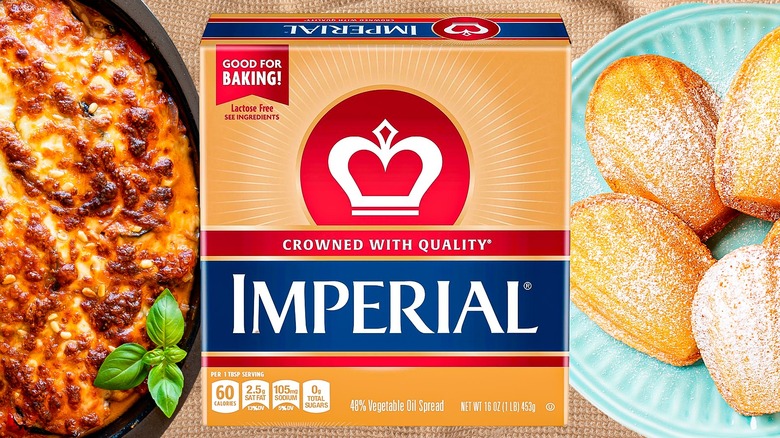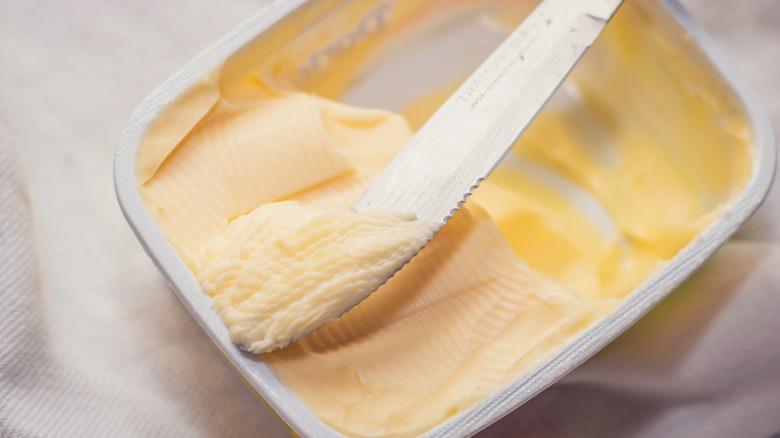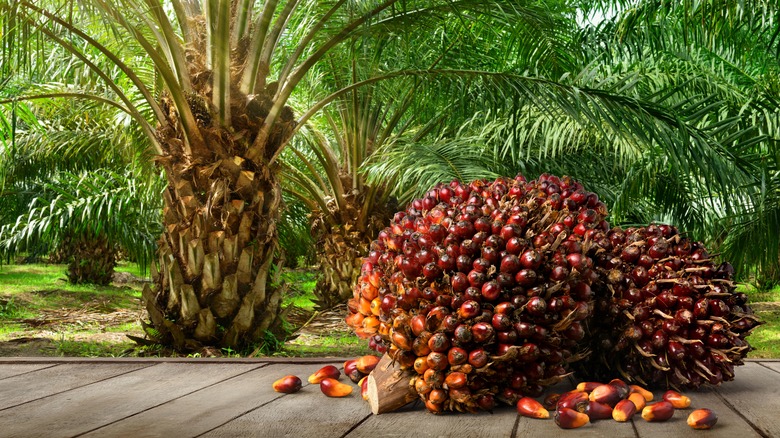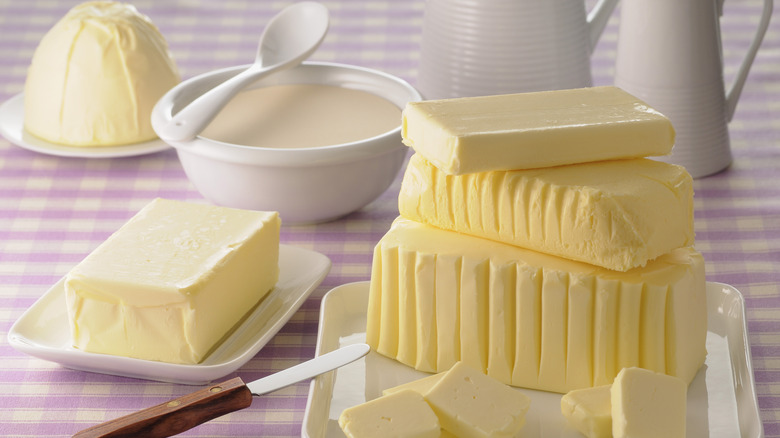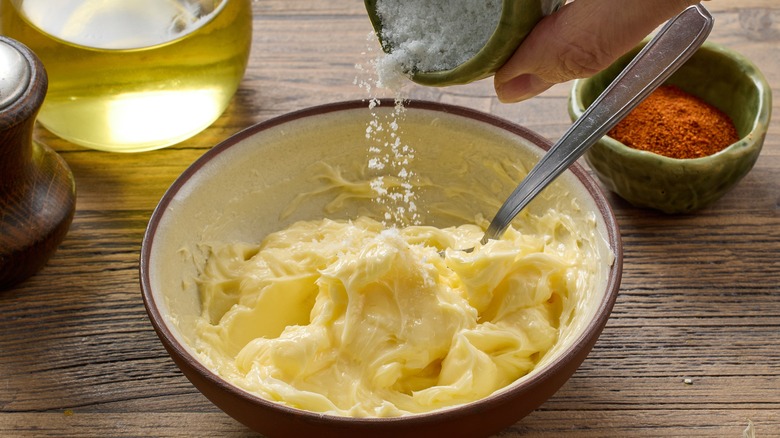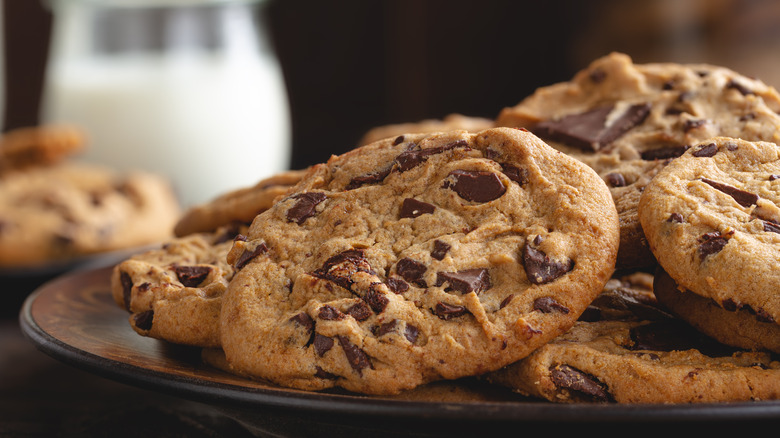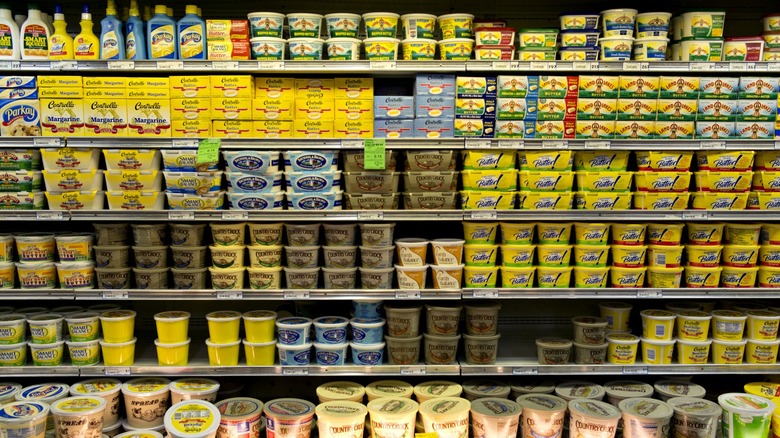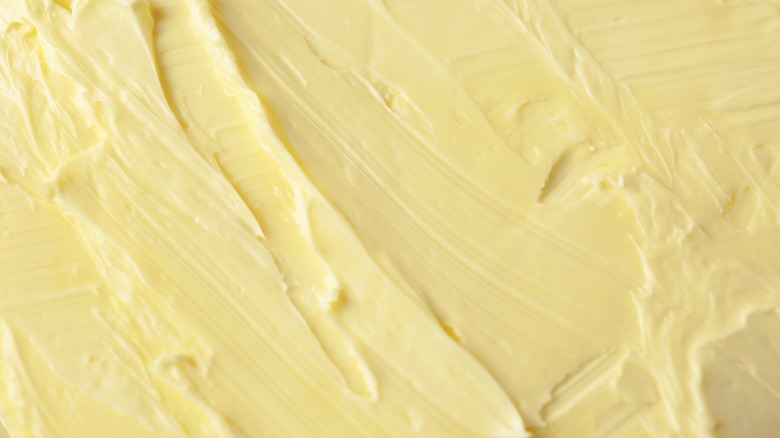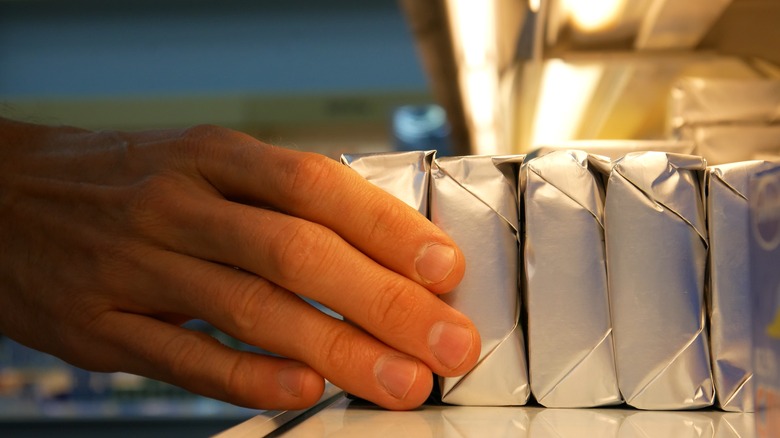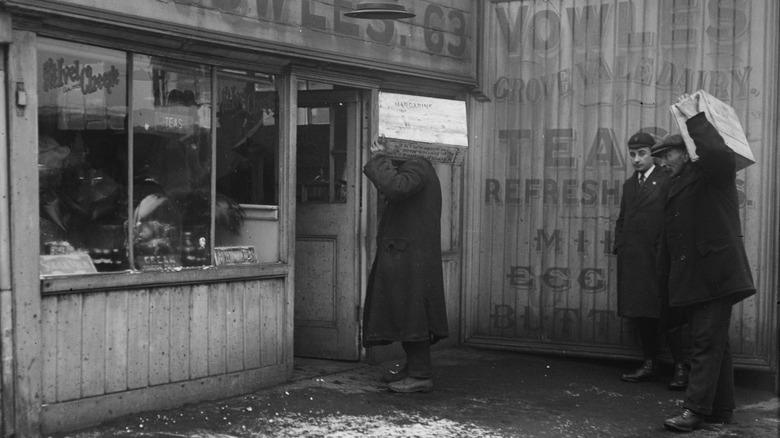What Exactly Is Imperial Butter And How Do You Use It?
These days there are at least as many types of butter substitutes out there as there are different types of butter. While everyone has their own idea of what the best butter substitute is, people of a certain age likely remember their grandmothers using something called Imperial butter in their kitchens. Upon buying a pack of Imperial butter sticks for the first time and opening it up yourself, however, its difference from regular butter will be readily apparent. This will likely raise the question of what exactly is Imperial butter, and how do you use it?
First and foremost, even though it comes in both stick and tub form much like regular butter, Imperial butter is not truly butter at all. It's actually a spread made from processed vegetable oils, more like margarine. However, it is important to note that speaking in non-colloquial, legal definitions only, Imperial butter is not known as margarine either, at least in the United States. Here's everything you need to know about Imperial butter, including what it's made of, what recipes do and don't benefit from its inclusion, and the surprising history behind this popular butter substitute.
What is Imperial butter?
Imperial butter is the common term for Imperial-brand vegetable oil spread, a widely available margarine-like substance that is used primarily in baking. What makes Imperial butter different from margarine is the amount of vegetable oil included in its ingredients – in the United States, if the product has less than 80% fat content by weight, it is classified as vegetable oil spread instead of margarine.
While humans have been harvesting oil from vegetables from at least as far back as 2000 BC, margarine and oil spreads as we know them today first began appearing around the mid-1800s. Although back then they were made of different ingredients than they are now — with a notable inclusion of beef fat. Today, Imperial butter and other brands of vegetable oil spread aren't quite as popular as butter, thanks to the rising knowledge of the negative aspects of processed food, particularly trans fats. Despite this, Imperial butter and other oil spreads are still often used as a butter substitute in many recipes. It's also useful to people on specialty diets: Today, Imperial brand vegetable oil spread is lactose-free, gluten-free, and cholesterol-free, and the labels state that it contains no trans-fat or partially hydrogenated oils per serving.
How is Imperial butter made?
Vegetable oil spread is made by emulsifying liquid vegetable oil and hard oil together with water and other ingredients. Imperial butter is made with a mixture of palm, soybean, and palm kernel oils. The reason palm kernel oil is used is because it has a higher saturated fat content when compared to other oils, therefore allowing Imperial butter sticks to hold their shape better at room temperature. These oils are processed with other ingredients like salt, coloring, and vitamin A to create the final product. Palm oil harvesting has been linked to environmental damage, like destroying the habitat of endangered species such as the pygmy elephant and Sumatran rhino. However, Imperial brand owner Upfield is upfront about reducing its ecological footprint. The company, which produces many other vegetable oil spread brands apart from Imperial, has a palm oil policy that commits to using 100% certified palm oil and palm kernel oil from plantations that don't deforest.
Imperial butter sticks and Imperial butter spread, while extremely similar, do contain slightly different ingredients. Imperial butter sticks are made with small amounts of pea protein and citric acid, for example, while Imperial butter spread does not include either ingredient but does include vinegar, which the sticks do not. Calcium disodium EDTA is also added to Imperial sticks to prevent the product from becoming spoiled. Preservatives like this are often added to vegetable oil spreads containing 65% fat or less.
Imperial vs. butter vs. margarine
Imperial butter, margarine, and regular butter are all different substances, although from their packaging and uses you would be forgiven for thinking they are basically the same thing. There are many, many different types of butter out there, but margarine and Imperial vegetable oil spread are more similar to each other than they are to butter. The biggest difference between margarine and butter is that butter is made from dairy products, such as milk or cream, while both margarine and vegetable oil spread are made from, well, vegetable oils and water.
Some margarines can contain high levels of fat, which in turn makes their taste and texture more similar to that of butter. As a vegetable oil spread, Imperial butter is greasier than regular butter and most margarines. Because of the water content in Imperial butter, baked goods like brownies tend to turn out softer when cooked with it over regular butter. Imperial butter is sometimes considered a healthier option than most other kinds of margarine and butter, since it contains 0g trans fat per serving, but that doesn't mean it is completely devoid of them. Imperial butter has 0.1g of trans fat per every two teaspoons — anything lower than 0.5g is allowed to say 0g on its packaging, per FDA regulations.
Is Imperial butter salted?
Imperial butter is salted. The addition of salt is an integral part of this vegetable oil spread's engineering process, and it is listed as the third most important ingredient in both Imperial stick and Imperial tub spread right after water and the necessary oils. Specifically, every serving of Imperial butter in stick form (1 tablespoon) contains 105mg of sodium, while each serving of Imperial butter in tub form (also 1 tablespoon) contains 95mg of sodium. This is slightly more sodium content than average butter; Land o' Lakes salted butter in stick form, for instance, contains 90mg of sodium for every 1 tablespoon serving.
The amount of salt is a very important difference between margarine and butter. Because of this, it's better to avoid using Imperial butter as a substitute for any recipe that calls for unsalted butter, especially when cooking baked goods. People who are looking to cut down on their sodium intake should not consider consuming more Imperial butter, but it is a fine replacement for regular, salted butter in many instances. However, if being used as a replacement, remember to keep in mind Imperial butter's more oily nature in addition to the higher sodium levels.
Is Imperial butter vegan?
Upfield (the parent company of Imperial) has promised to make all of its brands completely vegan by 2025, and packs labeled lactose-free are already vegan. Right now, however, there's a bit of controversy regarding Imperial spread in the vegan community — as Green Body Brand states during a breakdown of Imperial butter's ingredients, "... a strong argument against Imperial margarine rests on the fact that veganism is not only about the food you eat. It is a complete lifestyle and rejects everything coming from animal sources." This is directed towards Imperial's use of palm oil, the production of which has been called one of the leading causes of deforestation in biodiverse areas.
It's not just moral qualms about palm oil that give some vegans pause when considering the status of Imperial butter over other vegan butter brands. It's also the ingredients like mono and diglycerides, artificial flavoring, and vitamin A palmitate, all of which can be obtained from either plant or animal sources. Since the company has not disclosed where these ingredients come from, Imperial butter occupies a bit of a gray area when it comes to its vegan status. When considering the implications of palm oil harvesting in addition to these lingering questions, Imperial butter may fall more on the not-vegan side of the line to some, at least philosophically speaking. In practice, Imperial butter marked as lactose-free contains no whey or dairy products, so it is technically vegan.
What does Imperial butter taste like?
In its most basic form, Imperial butter doesn't taste like much and isn't often consumed on its own. Eleanor Roosevelt might have enjoyed toast with margarine over butter, but Imperial butter may be less pleasant tasting than most margarine types to some. It is a greasy, not-quite-flavorless, slightly salty spread, and is pretty much always better utilized as a cooking ingredient than as a topping or on its own. Because margarine and vegetable oil spreads have a higher melting temperature than butter, it does not melt in your mouth the same way butter does when you eat it. Instead, it leaves behind a slightly greasy aftertaste which some people may not find pleasurable.
Still, thanks to the rising popularity of margarine in the 1900s (before more detailed information about trans fats was widely known) and a highly successful marketing campaign from Imperial, many adults across the United States grew up with Imperial butter as a staple. Lots of people prefer the taste and texture of Imperial over butter and margarine simply because it is what they are most familiar with, or because of their personal preferences. Additionally, many cookbooks spanning from the 1960s to the 1990s have recipes that call for Imperial butter, which adds a nostalgic tinge to its flavor for many.
How to cook with Imperial butter
Because it's been around for over 50 years, there are hundreds (if not thousands) of recipes that call for Imperial butter. Many of them are simple – one easy sugar cookie recipe requires 2 sticks of Imperial butter to be mixed with 1 cup of sugar until it's fluffy, then beat in 1½ cups of flour, 1 teaspoon of baking soda, and 1 teaspoon of vinegar until combined. Dollop out 1 teaspoon-sized portions of dough onto the pan, bake for about 10 minutes at 350 degrees Fahrenheit, and you're all set. Every box of Imperial sticks even comes with a quick chocolate chip cookie recipe on the back.
When using Imperial as a butter substitute, remember the higher water content in vegetable oil spread will lead to a different result. The food will often be thicker and more oily than it would be if made with butter. This can be a net positive if you or your guests are fans of chewier brownies and cookies over crispy, cakier treats.
There are also more complicated ways to cook with Imperial butter. Many people enjoy mixing butter and margarine together when making cookies. Margarine is also useful for making creamy dipping sauces that need to be refrigerated as well as keep their consistency — if you are looking to make garlic dip like Domino's does, check out Tasting Table's breakdown on how margarine can be used to create restaurant-quality garlic sauce.
Where to buy Imperial butter
Imperial butter has been around for decades and is easily found in most supermarkets across the country, as well as from online retailers. Most stores like Food Lion, Kroger, and Walmart carry Imperial butter in both stick and tub form, but these locations generally only contain small Imperial packages for personal use. Restaurant owners and chefs looking to stock up their kitchens with Imperial butter should check out Amazon, where it is possible to purchase a case of six 45-ounce tubs of Imperial spread. Just don't use it without telling anyone if you're managing a restaurant in Delaware, where it is still illegal to serve margarine without notice.
Because of its ubiquity over the past few decades, finding Imperial butter is a simple process. The most important thing to remember when searching for the product, whether it be online or in stores, is to always call it Imperial spread to avoid any confusion. Neither the words butter or margarine appear on the packaging. While it was officially marketed as Imperial margarine and colloquially called Imperial butter for a long time, current FDA regulations require it to be labeled as a vegetable oil spread. As such, this is what most supermarkets will have Imperial butter labeled as in their internal systems.
Nutritional information about Imperial butter
Imperial butter contains slightly different nutrition facts depending on whether it is in its stick or tub form. Imperial sticks are a 50% vegetable oil spread, usually sold in a 1-pound box containing 4 sticks. Normal servings are a single tablespoon, with each containing 7g of total fat, 3g of saturated fat, 105mg of sodium, and a listed 0g of trans fat, total carbohydrate, dietary fiber, and protein. In total, each serving of Imperial butter sticks contains 60 calories and 10% of your daily value of vitamin A.
In contrast, a 45-ounce tub of Imperial butter contains 91 single-tablespoon servings of 27% vegetable oil spread, with each serving containing 4g of total fat composed of 1g of saturated fat, 2g of polyunsaturated fat, and 1g of monounsaturated fat. Every tablespoon serving also contains 95mg of sodium (slightly less than Imperial stick butter) and a listed 0g of protein, total carbohydrate, and trans fat. Like Imperial sticks, each serving also contains 10% of the recommended daily value of vitamin A. Imperial butter (in all forms) is gluten- and lactose-free.
How to store Imperial butter
No matter whether you are dealing with Imperial sticks or vegetable oil spread in a tub, it is important to ensure it is stored correctly. Both forms of Imperial butter should be kept refrigerated at all times at 40 degrees Fahrenheit or below. Most margarines and vegetable oil spreads have a longer shelf life than normal butter thanks to their more processed nature, and Imperial spread is no different. That being said, it's still important to pay attention to the manufacturer's printed use-by date, as well as to remember to keep an eye out for common signs of spoilage.
A noticeable change in texture, like the oil and water separating when the substance is spread, is an obvious signal that your Imperial butter is on its last legs. Additionally, a soapy or paint-like smell or a bitter taste are both clear signs your vegetable oil spread has gone bad. It's also good to pay attention to the color of the Imperial butter itself — margarine which has had too much access to air for too long will get darker through oxidation.
After you've finished off a tub of Imperial butter spread, it may be tempting to keep the plastic tub itself to use for future leftovers. If this is something you've been doing, it might be good to take a moment and check out our article on why it's a bad idea to reuse margarine tubs for leftovers.
Napoleon III's history with Imperial butter
Imperial butter, and all forms of margarine and vegetable oil spreads, can trace their existence back to Emperor Napoleon III and a French chemist named Hippolyte Mège-Mouriès. Originally developed as oleomargarine, margarine was created by Mège-Mouriès for an 1869 competition the emperor held during the Franco-Prussian war, which had left the country desperately short on butter.
Despite Mège-Mouriès' contribution, which used beef tallow instead of the vegetable oils that would become popular later, he would never find fame or fortune with his discovery. Before he died in 1880, Mège-Mouriès sold his patent to the Dutch butter company Jurgens & Co., which still exists today as Unilever. It was Jurgens & Co. that truly popularized the use of margarine by making a now-obvious choice; they made the product look more like butter.
Once margarine appeared in North America in the 1870s, it wasn't long before dozens of companies were making their own versions of it. While lobbying from the worried dairy industry led to strict regulations on margarine sales for nearly a century, that didn't stop the rise of margarine's popularity. Imperial butter is just one of the brands that rose to fame in the 1950s and 1960s, but thanks to its long history and catchy commercial jingles, it is one many people still think of fondly.
